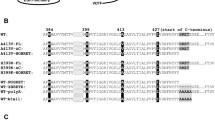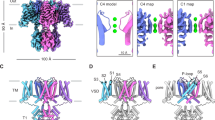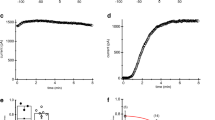Abstract
The basophilic leucaemia cell line RBL-2H3 exhibits a robust inwardly rectifying potassium current, I KIR, which is likely to be modulated by G proteins. We examined the physiological and molecular properties of this KIR conductance to define the nature of the underlying channel species. The macroscopic conductance revealed characteristics typical of classical K+ inward rectifiers of the IRK type. Channel gating was rapid, first order (τ ≈ 1 ms at −100 mV) and steeply voltage dependent. Both activation potential and slope conductance were dependent on extracellular K+ concentration ([K+]o) and inward rectification persisted in the absence of internal Mg2+. The current was susceptible to a concentration- and voltage-dependent block by extracellular Na+, Cs+ and Ba2+. Initial I KIR whole-cell amplitudes as well as current rundown were dependent on the presence of 1 mM internal ATP. Perfusion of intracellular guanosine 5′-Q-(3-thiotriphosphate) (GTP[γS]) suppressed I KIR with an average half-time of decline of approximately 400 s. It was demonstrated that the dominant IRK-type 25 pS conductance channel was indeed suppressed by 100 μM preloaded GTP[γS]. Reverse transcriptase-polymerase chain reactions (RT-PCR) with RBL cell poly(A)+ RNA identified a full length K+ inward rectifier with 94% base pair homology to the recently cloned mouse IRK1 channel. It is concluded that RBL cells express a classical voltage-dependent IRK-type K+ inward rectifier RBL-IRK1 which is negatively controlled by G proteins.
Similar content being viewed by others
References
Ashford MLJ, Bond CT, Blair TA, Adelman JP (1994) Cloning and functional expression of a rat heart KATP channel. Nature 370:456–459
Bauer CK, Meyerhof W, Schwarz JR (1990) An inward-rectifying K+ current in clonal rat pituitary cells and its modulation by thyrotrophin-releasing hormone. J Physiol (Lond) 429:169–189
Beaven, MA, Rogers J, Moore JP, Hesketh TR, Smith A, Metcalfe JC (1984) The mechanism of the calcium signal and correlation with histamine release in RBL-2H3 cells. J Biol Chem 259:7129–36
Chen C, Okayama H (1987) High-efficiency transformation of mammalian cells by plasmid DNA. Mol Cell Biol 7:2745–52
Chomczynski P, Sacchi N (1987) Single-step method of RNA isolation by acid guanidinium thiocyanate-phenol-chloroform extraction. Analytic Biochem 162:156–159
Dascal N, Schreibmayer W, Lim NF, Wang W, Chavkin C, DiMagno L, Labarca C, Kieffer BL, Gaveriaux-Ruff C, Trollinger D, Lester HA, Davidson N (1993) Atrial G proteinactivated K+ channel: expression cloning and molecular properties. Proc Natl Acad Sci USA 90:10235–10239
Hagiwara S, Miyazaki S, Rosenthal NP (1976) Potassium current and the effect of cesium on this current during anomalous rectification of the egg cell membrane of a starfish. J Gen Physiol 67:621–638
Hamill OP, Marty A, Neher E, Sakmann B, Sigworth FJ (1981) Improved patch-clamp techniques for high-resolution current recordings from cells and cell-free membrane patches. Pflügers Arch 391:85–100
Hille B (1992) Ionic channels of excitable membranes, 2nd edn. Sinauer, Sunderland, Mass.
Hille B, Schwarz W (1978) Potassium channels as multi-ion single-file pores. J Gen Physiol 72:409–442
Ho K, Nichols CG, Lederer WJ, Lytton J, Vassilev PM, Kanazirska MV, Hebert SC (1993) Cloning and expression of an inwardly rectifying ATP-regulated potassium channel. Nature 362:31–38
Horie M, Irisawa H, Noma A (1987) Voltage-dependent magnesium block of adenosine-triphosphate-sensitive potassium channel in guinea-pig ventricular cells. J Physiol 387:251–72
Hoyer J, Popp R, Meyer J, Galla HJ, Gögelein H (1991) Angiotensin II, vasopressin and GTP[γS] inhibit inward-rectifying K+ channels in porcine cerebral capillary endothelial cells. J Membr Biol 123:55–62
Ishihara K, Mitsuiye T, Noma A, Takano M (1989) The Mg2+ block and intrinsic gating underlying inward rectification of the K+ current in guinea-pig cardiac myocytes. J Physiol (Lond) 419:297–320
Janiszewski J, Bienenstock J, Blennerhassett MG (1992) Substance P induces whole cell current transients in RBL-2H3 cells. Am J Physiol 263:C736-C742
Karschin A, Wischmeyer E, Davidson N, Lester HA (1994) Fast inhibition of inwardly rectifying K+ channels by multiple neurotransmitter receptors in oligodendroglia. Eur J Neurosci 6:1756–1764
Koyama H, Morishige KI, Takahashi N, Zanelli JS, Fass DN, Kurachi Y (1994) Molecular cloning, functional expression and localization of a novel inward rectifier potassium channel in the rat brain. FEBS Lett 341:303–307
Kubo Y, Reuveny E, Slesinger PA, Jan YN, Jan LY (1993) Primary structure and functional expression of a rat G-protein-coupled muscarinic potassium channel. Nature 364:802–806
Kubo Y, Baldwin TJ, Jan YN, Jan LY (1993) Primary structure and functional expression of a mouse inward rectifier potassium channel. Nature 362:127–133
Kurachi Y (1985) Voltage-dependent activation of the inward-rectifier potassium channel in the ventricular cell membrane of guinea-pig heart. J Physiol (Lond) 366:365–385
Kurtz A, Penner R (1989) Angiotensin II induces oscillations of intracellular calcium and blocks anomalous inward rectifying potassium current in mouse renal juxtaglomerular cells. Proc Natl Acad Sci USA 86:3423–3427
Lewis DL, Ikeda SR, Aryee D, Joho RH (1991) Expression of an inwardly rectifying K+channel from rat basophilic leukemia cell mRNA in Xenopus oocytes. FEBS Lett 290:17–21
Lindau M, Fernandez JM (1986) A patch-clamp study of histamine-secreting cells. J Gen Physiol 88:349–68
Makhina EM, Kelly AJ, Lopatin AN, Mercer AW, Nichols CG (1994) Cloning and expression of a novel human brain inward rectifier potassium channel. J Biol Chem 269:20468–20474
Masuda H, Sperelakis N (1993) Inwardly rectifying potassium current in rat fetal and neonatal ventricular myocytes. Am J Physiol 265:H1107–1111
Matsuda H (1988) Open-state substructure of inwardly rectifying potassium channels revealed by magnesium block in guinea-pig heart cells. J Physiol (Lond) 397:237–58
Matsuda H (1991) Effects of external and internal K+ ions on magnesium block of inwardly rectifying K+ channels in guinea-pig heart cells. J Physiol (Lond) 435:83–99
Matsuda H, Saigusa A, Irisawa H (1987) Ohmic conductance through the inwardly rectifying K channel and blocking by internal Mg2+. Nature 325:156–159
McCloskey MA, Cahalan MD (1990) G protein control of potassium channel activity in a mast cell line. J Gen Physiol 95:205–27
McNicholas CM, Wang W, Ho K, Hebert SC, Giebisch G (1994) Regulation of ROMK1 K+channel activity involves phosphorylation processes. Proc Natl Acad Sci USA 91:8077–8081
Morishige KI, Takahashi N, Findlay I, Koyama H, Zanelli JS, Peterson C, Jenkins NA, Copeland NG, Mori N, Kurachi Y (1993) Molecular cloning, functional expression and localization of an inward rectifier potassium channel in the mouse brain. FEBS Lett 336:375–380
Morishige KI, Takahashi N, Jahangir A, Yamada M, Koyama H, Zanelli JS, Kurachi Y (1994) Molecular cloning and functional expression of a novel brain-specific inward rectifier potassium channel. FEBS Lett 346:251–256
Mukai M, Kyogoku I, Kuno M (1992) Calcium-dependent inactivation of inwardly rectifying K+ channel in a tumor mast cell line. Am J Physiol 262:C84-C90
Nakajima Y, Nakajima S, Inoue M (1988) Pertussis-toxin-insensitive G protein mediates substance P-induced inhibition of potassium channels in brain neurons. Proc Natl Acad Sci USA 85:3643–3647
Nichols CG, Ho K, Hebert S (1994) Mg2+-dependent inward rectification of ROMK1 potassium channels expressed in Xenopus oocytes. J Physiol (Lond) 476:399–409
Nilius B, Schwarz G, Droogmans G (1993) Modulation by histamine of an inwardly rectifying potassium channel in human endothelial cells. J Physiol (Lond) 472:359–371
Périer F, Radeke CM, Vandenberg CA (1994) Primary structure and characterization of a small-conductance inwardly rectifying potassium channel from human hippocampus. Proc Natl Acad Sci USA 91:6240–6244
Piguet P, North RA (1992) The inward rectifier potassium conductance in rat basophilic leukemia cells. J Cell Physiol 151:269–275
Sakmann B, Trube G (1984) Voltage-dependent inactivation of inward-rectifying single-channel currents in the guinea-pig heart cell membrane. J Physiol (Lond) 347:659–683
Standen NB, Stanfield PR (1978) A potential and time-dependent blockade of inward rectification in frog skeletal muscle fibres by barium and strontium ions. J Physiol (Lond) 280:169–181
Stanfield PR, Nakayima Y, Yamakuchi K (1985) Substance P raises neuronal membrane excitability by reducing inward rectification. Nature 315:498–501
Stanfield PR, Davies NW, Shelton PA, Khan IA, Brammar WJ, Standen NB, Conley EC (1994) The intrinsic gating of inward rectifier K+ channels expressed from the murine IRK1 gene depends on voltage, K+ and Mg2+. J Physiol (Lond) 475:1–7
Stanfield PR, Davies NW, Shelton PA, Sutcliffe MJ, Khan IA, Brammar WJ, Conley EC (1994) A single aspartate residue is involved in both intrinsic gating and blockage by Mg2+ of the inward rectifier, IRK1. J Physiol (Lond) 478:1–6
Taglialatela M, Wible BA, Caporaso R, Brown AM (1994) Specification of pore properties by the carboxyl terminus of inwardly rectifying K+ channels. Science 264:844–847
Tang W, Yang XC (1994) Cloning a novel human brain inward rectifier potassium channel and its functional expression in Xenopus oocytes. FEBS Lett 348:239–243
Vandenberg CA (1987) Inward rectification of a potassium channel in cardiac ventricular cells depends on internal magnesium ions. Proc Natl Acad Sci USA 84:2560–2564
Zhang H, Inazu M, Weir B, Daniel E (1994) Endothelin-1 inhibits inward rectifier potassium channels and activates nonspecific cation channels in cultured endothelial cells. Pharmacology 49:11–22
Author information
Authors and Affiliations
Rights and permissions
About this article
Cite this article
Wischmeyer, E., Lentes, K.U. & Karschin, A. Physiological and molecular characterization of an IRK-type inward rectifier K+ channel in a tumour mast cell line. Pflügers Arch. 429, 809–819 (1995). https://doi.org/10.1007/BF00374805
Received:
Revised:
Accepted:
Issue Date:
DOI: https://doi.org/10.1007/BF00374805




